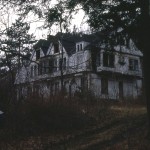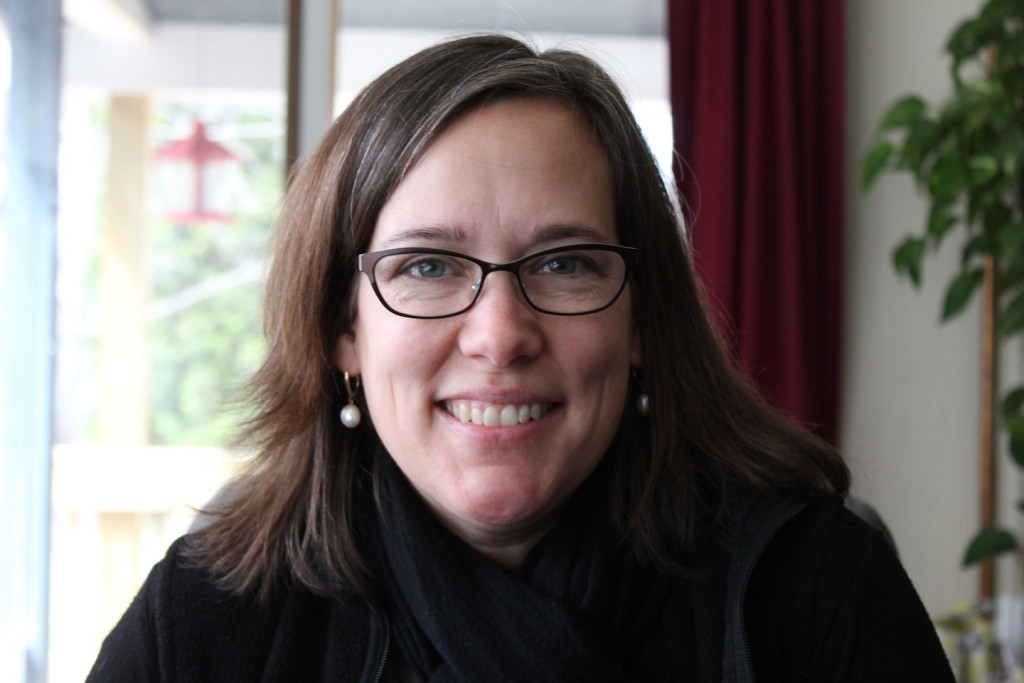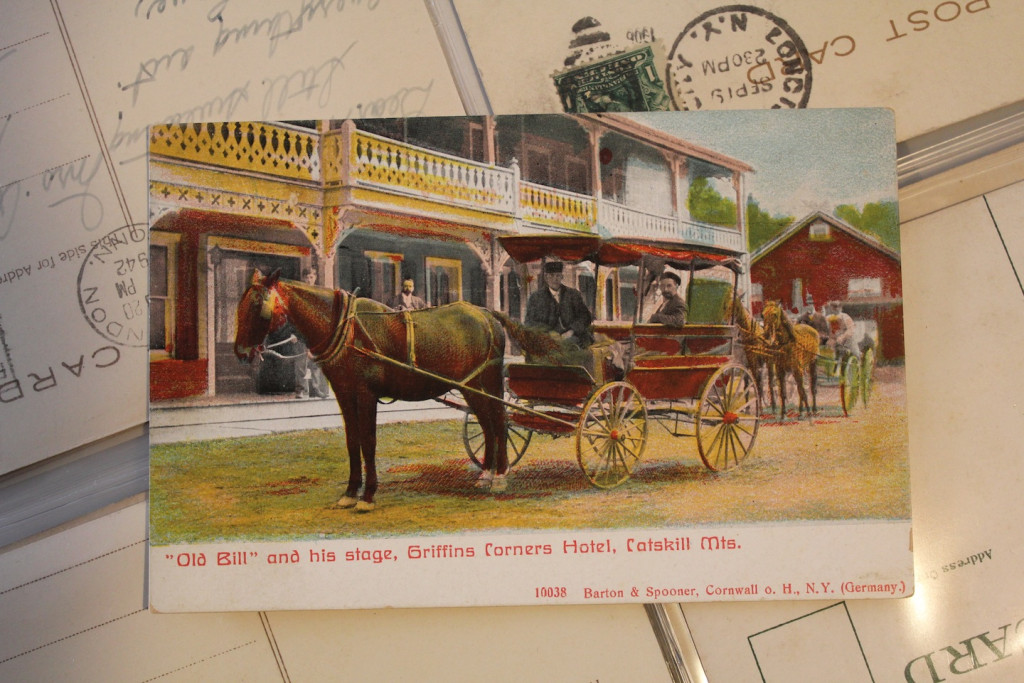How long have you lived in the Catksills?
I moved upstate with my family in 1979 when I was nine years old and my parents were partners with my mother’s parents – my grandparents – at the Emery Brook House, that’s now the Evergreen. They ran it as a German Cuisine bed and breakfast.
Were you born here?
I was born in Huntington, Long Island.
So what made your family move to the Catskills?
Well, my grandparents had found the area. They had a boarding house in Rockaway and the area was being developed so they had to sell, or were bought out. I don’t really remember the story of how they left Rockaway, but they were looking for a German community and that’s how they wound up in Fleischmanns. There was a nice German community here and they were looking for a similar situation to what they had left: a boarding house. So when they contacted a real estate person in the area, the real estate person told them about the St Regis, which is huge and much bigger than anything they had envisaged managing, so they then found the Emery Brook and that’s where they settled.
How many years did they have that?
I’d say they probably had it for ten years. They sold it to a family who lived there and didn’t rent it out.
It must have been really fun to grow up around here.
I was really pleased with it. I was young enough to not miss Long Island at all. I was very happy to move upstate.
It’s quite a big change from surfer girl to mountain girl.
I didn’t spend much time at the beach actually. Plus I was young enough where it wasn’t like I was doing things independently. My parents were very busy. There were kids on the block that I played with: that part I miss. There was a whole social aspect to living in a suburb. You have your friends on the block. You’re allowed to go out and play. Here there weren’t that many people in town and I still have the same issue with my kids. You really have to drive your kids someplace to have a play date. But I guess that’s better anyway. Nowadays you don’t want your kids running around.
I find that in America in general you have such a large amount of space unless you’re in the city. That’s why you have to drive everywhere because, if you have ten acres, you should. You can grow your own food, etc.
One of the things I was overjoyed about when we moved upstate was that we had all this property behind us and I was able to go hiking in the woods and it was something that my mum allowed. She wouldn’t really let me take my bike into town until I was older, but she would let me walk in the woods behind the house. Maybe a mile and a half up through the woods there was Paradise Camp and at the time there were still buildings there. They had fallen into disrepair, but you could go in them and look around. That kind of exploration was amazing to me as a child and this picture I have here is of Takanassee. My mum strictly forbade me to go into this building because it was very dilapidated.
 It looks like it might swallow you in and not let you go. It looks haunted.
It looks like it might swallow you in and not let you go. It looks haunted.
Yes, and I did sneak in there once, against my mother’s wishes, and there was a lot of evidence that it was a party house. That kids went in there, and there were a lot of beer cans, spray paint and stuff.
Did you take that picture?
My Dad did. You can see that people are still trying to collect maple syrup off the property.
Where did you go to college?
I went to Indiana University of Pennsylvania. One of my mentors at Margaretville Central, Bill Birns who is a Fleischmannite. had gone there.
I would love to interview him.
That would be great. He is a wonderful person and very interesting.
So did you go away to college and come back again?
Yes, I didn’t finish college. I don’t have a degree. I wanted to travel and learn about the world.
Travel broadens the mind.
I left college with a friend and I travelled across country in a van and camped out, met people and had a great time. We wound up in San Francisco but my favorite place was the southwest. We spent a lot of time there and that’s how I wound up moving to Santa Fe, New Mexico many years later to spend a year.
You spent a year in Santa Fe and then came back because you met Todd.
Yes.
So you came back and got married and you’re really active in the community in Fleischmanns.
When Todd and I decided to buy the house here. We always knew we would be involved somehow in helping to make Fleischmanns a better place to live. One of the first things I got involved in was the Fleischmanns Revitalization Committee because of the playground, which was really awful at the time. But at that time there had been pools of money raised to build a new playground, but there were different issues with picking a design and there was some disagreement about things, so the idea was shelved a couple of times. There was only $4-5,000 in the pool.
How much is a new playground?
You could spend $50,000 very easily for a very basic playground.
Oh my god.
What was in there at the time was a $35,000 playground, but that didn’t have any of the surfacing that was required to be put down.
Spongy surfacing?
Exactly. It’s mind blowing the amount of money that it costs. It’s like building a house.
Yes, couldn’t you just find an empty house that the kids could play in like you had when you were younger?
[Laughs] As long as they don’t fall through the staircase.
What’s the most important thing about Fleischmanns now do you think?
I just had this great experience. I went to the Outdoor Adventure Tourism Summit at Spillian and in the evening there was a Delaware County Business Mixer and the lady I was sitting next to said the most wonderful thing. She was saying she really loved Fleischmanns and I probably said something like it had a lot to overcome. Then she said that the wonderful thing about Fleischmanns is that it’s really authentic. Fleischmanns has so much to offer. Yes, there maybe some dilapidated buildings, but there’s so much potential.
So you make jewelry?
When I moved back from New Mexico, I had decided that I didn’t want to waitress anymore, so I started making jewelry, which I had always done – beaded jewelry – since I was a little girl and start a business. I also made beaded candleholders with little glass gems. So had started selling these crafts at street fairs and I tried to sell at the Round Barn. Then I met Jill Kline and she was doing her felting. So from seeing each other at events and stuff, we became friends and she had asked a group of us who were always at the same events if we wanted to start a collective. So that’s really how the Catskill Mountain Artisan Guild came about. Eventually, Jill and I said, let’s make this real. So she and I did that. For years I did sell my crafts at the Guild.
I use their soap: lemongrass and rose. You’ve kind of inspired me to start making jewelry again because I get stuck in my head a lot. I spend a lot of time in front of a computer.
It’s like meditation.
What inspires you most about the Catskills?
I love it here because I find the mountains very grounding. I’ve travelled a lot and I’ve lived a lot of different places, but I always come back and it’s not just because this is where my parents are, it’s also because I feel very nurtured here in the mountains. Since I’ve had kids, I do not get out in the woods as much as I’d like to and I’m always trying to change that. But I would say that being in the woods reminds me of who I am. And it calms me.
I’m asking this question of everybody lately: what is work?
I think the real work we do in life is the work we do on ourselves. I think the real work is working on becoming a better person and developing ourselves. The work that we do for a living that we have to is not the real work of our lives.


She’s just a newcomer to Fleischmanns. I popped in back in 1944, stayed at the Emory Brook House and moved into a 1920’s farmhouse back in 1952. Still livin’ there.
Got an art gallery that no one ever comes to. Looking for some publicity. I’m a walking encyclopedia of Fleischmanns but no one seems to give a damn.
Did you read my comment below? I would love help on my project if you have any information.
I don’t have any information for you, sorry.
I am glad to have read this. Not only is it a beautiful piece, and I am happy that someone is preserving the area’s history and culture, but I am personally looking for photos or video of the broken down campgrounds, that were Paradise camp. It is very difficult to find anything on the grounds. I especially have not been able to find anything from when the camp was actually open. The earliest photos I can find are from the late 70s after it had already burnt down.
I am looking for information pertaining to the campgrounds. For instance, when it burnt down, why it was abandoned, and how many years it was open for.
The earliest mention of the camp I found was in 1899. But I cannot tell if that is the same camp as the one in Fleischmanns, since the article is for all of the Catskills and it is possible there was another paradise camp. 1944 is the next mension of it I can find and that one is definitely the one in Fleischmanns. There are advertisements of it from 1944-1954
The camp shut down during the year of 1955 and reopend in 1956 with new management. After that, I cannot find any information.
I’m trying to figure out when it stopped operating, when it burnt down, and really any information pertaining to it. If anyone can point me in the right direction I would greatly appreciate it. Thank you
Its so crazy that such a large piece of history just vanished without any traces… thank you though
I would check with Craig Cherry,Arlenne Stanford, Yvonne Reuter,Marilyn Rengal.I’m assuming that you aleready checked in with John Duda at Fleischmanns Museum.Forgive me if these are so obvious that you first checked with them.Also Bill Birnes and Diane Galusha